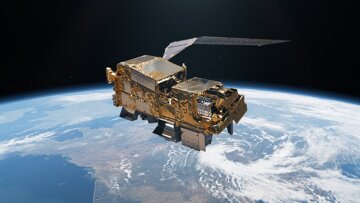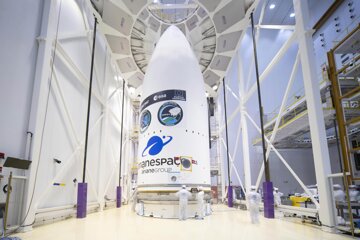European satellites with Dutch technology provide better insights about weather and atmosphere
Better weather forecasts and more knowledge about the composition of the atmosphere: that is what we can expect from two new European meteorological satellites. Earlier this summer, MTG-S1 was already launched. Today, MetOp-SG A1 is send into space. The Netherlands is closely involved in both satellite missions.
Tonight at 2:37 a.m. Dutch time, Europe launches an Ariane 6-2 rocket carrying the first in a new generation of meteorological satellites: MetOp-SG-A1. The launch is followed with great interest in the Netherlands, as Dutch companies and organisations are making important contributions to the mission. The Dutch society also has a strong interest in the data that the mission will deliver.
On board the satellite are six instruments, including one from the European Copernicus programme: Sentinel-5. This is the successor to the Dutch satellite instrument TROPOMI, which has been studying air quality worldwide since 2017. “TROPOMI measures the atmosphere in the afternoon, while Sentinel-5 makes observations in the morning,” says Bram Maasakkers from the space research institute SRON. “So we are gaining a valuable new source of information.”

Een artist impression of satellite MetOp-SG-A1 © ESA
Example of European cooperation
SRON has been involved in all phases of the Sentinel-5 mission. This started more than fifteen years ago, when the specifications of the instrument were defined. The institute then built a “submerged grating” – the Dutch innovation that also allows TROPOMI to measure methane and carbon monoxide in the atmosphere with great precision. Finally, SRON worked on algorithms and data analysis needed to understand the observations from the satellite instrument.
The Dutch company S&T also developed algorithms to translate raw satellite data from Sentinel-5 into usable information for users. TNO contributed to Sentinel-5 with two telescope systems, a spectrometer for UV radiation, and test equipment to calibrate and test the satellite instrument extensively on Earth. “This mission is an example of European cooperation, but also of Dutch innovation power,” says Adriaan van ’t Hof from TNO. “What we learned from TROPOMI we used for Sentinel-5. And everything we learned in this complex mission can be applied to the next Earth observation mission we will build here in the Netherlands: TANGO.”
Better flood forecasting
Sentinel-5, which orbits the Earth in a polar orbit, is not the only mission with Dutch contributions launched this summer. On 1 July, Sentinel-4 was sent into space aboard the MTG-S1 satellite. The satellite is powered by solar panels made by Airbus Netherlands. MTG-S1 orbits in a geostationary position above Africa and Europe and will make an important contribution to our daily weather forecasts, especially for severe weather.
“Sentinel-4 measures temperature and humidity in the atmosphere,” says Jan Fokke Meirink from KNMI. “This data is crucial if you want to predict storms and heavy rain in time. Sentinel-4 helps us to forecast floods like those in Limburg in 2021 earlier and warn people on time about severe weather.”
Reliable measurements worldwide
KNMI will use data from both Sentinel-4 and Sentinel-5 a lot. To feed its own weather model HARMONIE with reliable data. To do research on the properties of aerosols and clouds, which have a big influence on our climate. And to improve air quality forecasts further.
Ellen Verolme, director-general of KNMI: “You cannot place measuring stations everywhere in the world. That is why we use satellites, which provide reliable observations year after year and cover the whole world. For our research on climate, air quality, and for our Early Warning Centre, which issues weather warnings in yellow, orange, and red, these new European satellites are very valuable.”
Investing in innovation power
The two European meteorological missions make one thing very clear, says NSO board member Joost Carpay: how much the Netherlands contributes to and benefits from European cooperation in space. “These satellites connect to four of the six ‘missions’ in our Long-term Space Agenda. From hardware for the satellites and the Ariane 6 rocket to the use of data that becomes available to everyone, the Netherlands is fully involved.”
Carpay stresses that space is a matter of long-term commitment. It takes ten, sometimes twenty years to prepare and build missions. Only then can you benefit from the data for scientific research and societal use.
“If the Netherlands wants to continue playing a top role in space in the future, we must keep investing. The next opportunity for this is during the ESA Ministers Conference in November, where member states decide ESA’s direction and how much and in which programmes they will invest.”

MetOp-SG-A1 getting ready for launch © ESA